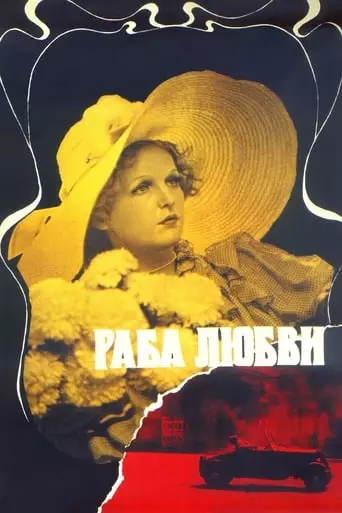
A Slave of Love (1976) Watch Online Free
Olga Voznesenskaya is a silent screen star whose pictures are so popular that underground revolutionaries risk capture to see them. She’s in southern Russia filming a tear-jerker as the Bolsheviks get closer to Moscow. Although married, she spends time every day with Victor Pototsky, the film’s cameraman. Gradually, it comes to light that Victor uses his job as a cover for filming White atrocities and Red heroism: he’s a Bolshevik. He asks her for help, and she discovers meaning in her otherwise flighty and self-centred life. Love blooms. Will the Red forces arrive in time to save them from a suspicious White military leader? Will she find courage?
A Slave of Love is a 1975 Soviet film directed by Nikita Mikhalkov, set during the Russian Civil War in 1918. The narrative centers on Olga Voznesenskaya, a celebrated silent film actress whose popularity endures even amidst the turmoil of revolution. As the Bolsheviks advance, Olga and her film crew relocate to Odessa to continue their work. During this period, Olga becomes romantically involved with Viktor Pototsky, the film’s cameraman, who is secretly a Bolshevik sympathizer documenting White Guard atrocities. Their relationship evolves as Olga becomes increasingly aware of the political realities surrounding her, leading to a profound transformation in her understanding of love and revolution.
The film explores the intersection of personal relationships and political upheaval. Olga’s journey from a self-absorbed actress to a woman awakened to the revolutionary cause mirrors the broader societal shifts of the time. Her involvement with Viktor symbolizes the merging of personal passion with political commitment, highlighting the transformative power of love in the face of societal change.
Mikhalkov examines the role of art in revolutionary movements, portraying the film industry as both a tool for propaganda and a means of personal expression. The contrast between the superficiality of silent film productions and the harsh realities captured by Viktor’s clandestine footage underscores the tension between artistic escapism and the urgent need for political activism.
The film employs melodramatic elements to convey its political messages, using the conventions of the genre to critique the idealization of revolution. By juxtaposing the romanticized portrayal of love with the brutal realities of war, Mikhalkov offers a nuanced commentary on the complexities of revolutionary fervor and the human cost of political upheaval.
A Slave of Love serves as a meta-cinematic exploration, reflecting on the nature of filmmaking itself. Through the depiction of a film crew grappling with the challenges of production amidst political chaos, the film critiques the artifice of cinema and its potential to both distract from and illuminate the truth.
Upon its release, A Slave of Love received critical acclaim for its innovative narrative and stylistic approach. The film’s blending of melodrama with political commentary resonated with audiences and critics alike, solidifying Mikhalkov’s reputation as a filmmaker capable of profound social and political insights. Its influence extended beyond Soviet cinema, inspiring discussions on the role of art in revolutionary contexts and the ethical responsibilities of artists during times of political upheaval.
Mikhalkov’s direction showcases a masterful blend of melodrama and political allegory, creating a film that is both emotionally engaging and intellectually stimulating. The use of black-and-white inserts to represent historical footage contrasts with the colorized present, effectively distinguishing between the past and the present. This stylistic choice enhances the film’s thematic depth and visual appeal.
The film offers a nuanced portrayal of Olga Voznesenskaya, depicting her evolution from a self-centered actress to a politically conscious individual. Her transformation is compelling, providing insight into the human capacity for change and the impact of love and revolution on personal identity.
Set against the backdrop of the Russian Civil War, the film provides a vivid depiction of the era’s social and political dynamics. It offers viewers a window into the complexities of revolutionary Russia, highlighting the interplay between personal lives and national upheaval.
The film delves into profound themes such as the intersection of art and politics, the nature of revolutionary fervor, and the personal costs of societal change. These themes are explored with depth and sensitivity, encouraging viewers to reflect on the broader implications of the narrative.
The cast delivers compelling performances, particularly the portrayal of Olga by the lead actress. Her ability to convey the character’s internal conflict and transformation adds emotional depth to the film, making her journey both relatable and poignant.
By focusing on a film crew within the narrative, A Slave of Love offers a meta-cinematic commentary on the filmmaking process. This self-reflection adds a layer of complexity, inviting viewers to consider the role of cinema in shaping and reflecting societal values.
As a work of Soviet cinema, the film provides valuable insights into the cultural and ideological currents of the time. It serves as a historical artifact, reflecting the artistic and political sensibilities of the era, and offers a perspective on the role of cinema in revolutionary movements.
After viewing A Slave of Love, you may experience a profound sense of reflection on the interplay between personal desires and political convictions. The film’s exploration of love amidst revolution may evoke feelings of empathy for the characters’ struggles and transformations. The juxtaposition of melodramatic elements with political themes could lead to a nuanced understanding of the complexities inherent in revolutionary movements and the human condition. You might find yourself contemplating the ethical responsibilities of artists during times of political upheaval and the ways in which art can both reflect and influence societal change. The film’s emotional depth and intellectual richness are likely to leave a lasting impression, prompting further contemplation on the themes it presents.
